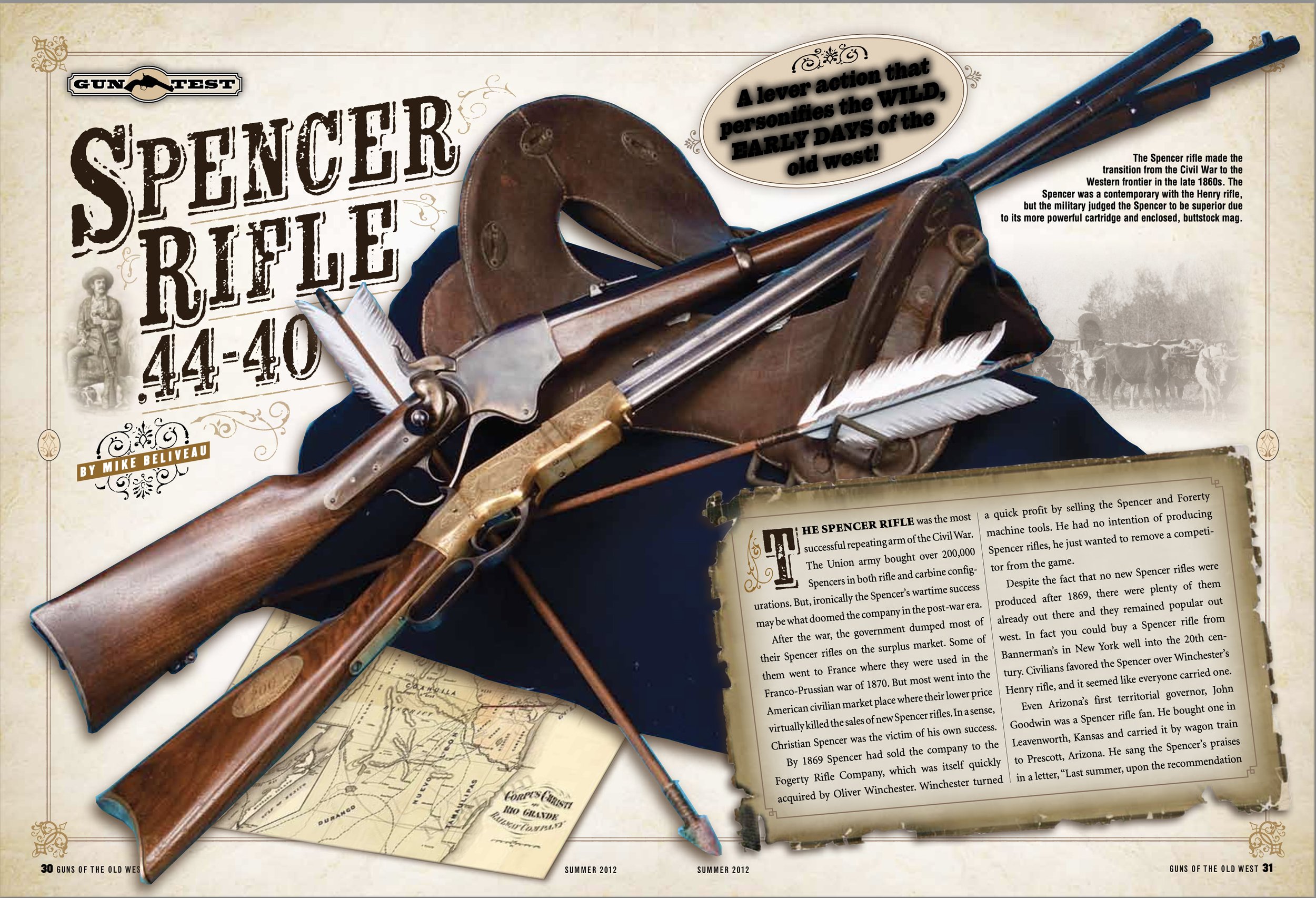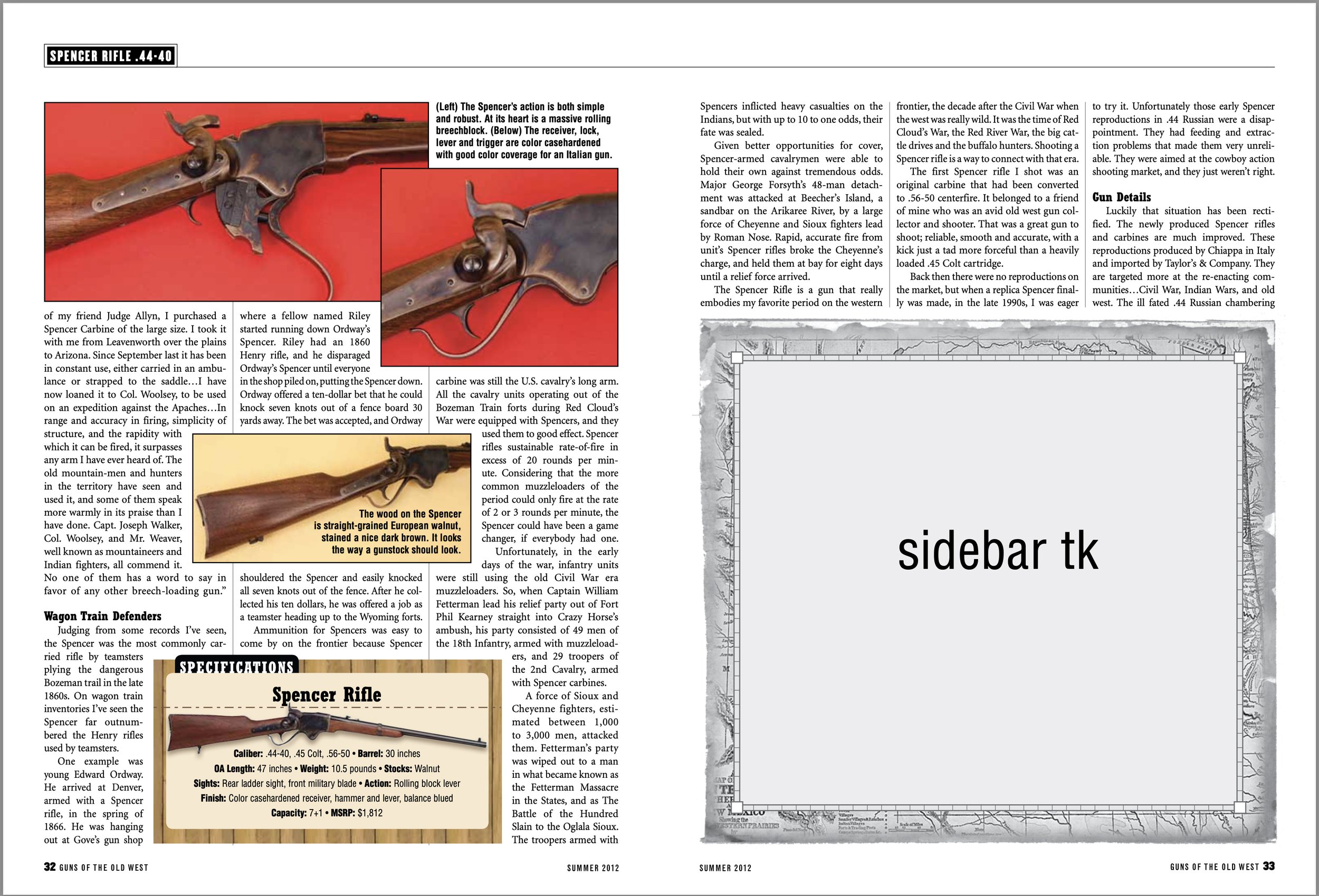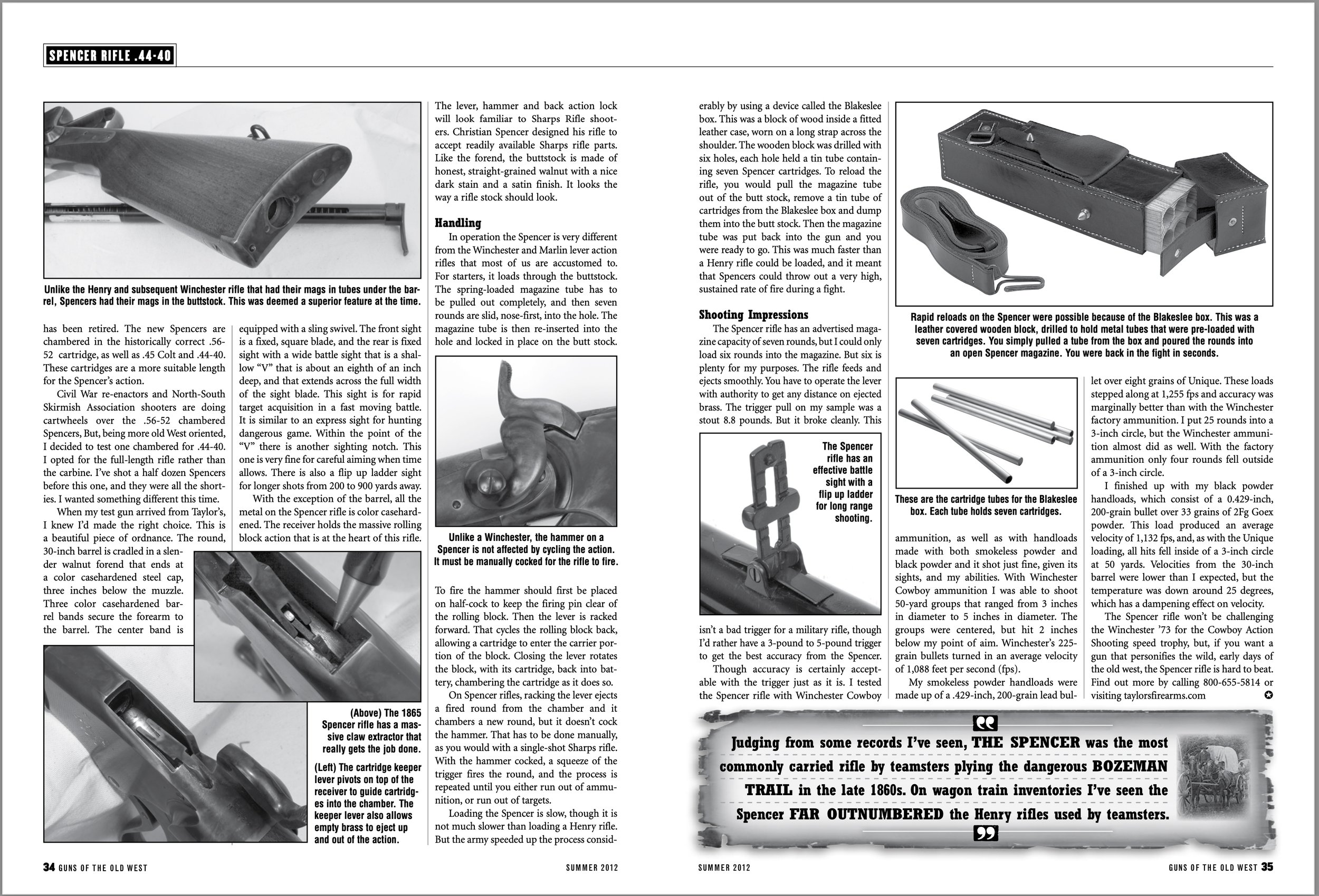Spencer Rifle - Taylor’s & Co.
The Spencer rifle was the most successful repeating arm of the Civil War. The Union army bought over 200,000 Spencers in both rifle and carbine configurations. But, ironically the Spencer’s wartime success may be what doomed the company in the post-war era.
After the war, the government dumped most of their Spencer rifles on the surplus market. Some of them went to France where they were used in the Franco-Prussian war of 1870. But most went into the American civilian market place where their lower price virtually killed the sales of new Spencer rifles. In a sense, Christian Spencer was the victim of his own success.
By 1869 Spencer had sold the company to the Fogerty Rifle Company which was itself quickly acquired by Oliver Winchester. Winchester turned a quick profit by selling the Spencer and Forerty machine tools. He had no intention of producing Spencer rifles, he just wanted to remove a competitor from the game.
Despite the fact that no new Spencer rifles were produced after 1869, there were plenty of them already out there and they remained popular out west. In fact you could buy a Spencer rifle from Bannerman’s in New York well into the twentieth century. Civilians favored the Spencer over Winchester’s Henry rifle, and it seemed like everyone carried one.
Even Arizona’s first territorial governor, John Goodwin was a Spencer rifle fan. He bought one in Leavenworth, Kansas and carried it by wagon train to Prescott, Arizona. He sang the Spencer’s praises in a letter,
““Last summer, upon the recommendation of my friend Judge Allyn, I purchased a Spencer Carbine of the large size. I took it with me from Leavenworth over the plains to Arizona. Since September last it has been in constant use, either carried in an ambulance or strapped to the saddle…I have now loaned it to Col. Woolsey, to be used on an expedition against the Apaches…In range and accuracy in firing, simplicity of structure, and the rapidity with which it can be fired, it surpasses any arm I have ever heard of. The old mountain-men and hunters in the territory have seen and used it, and some of them speak more warmly in its praise than I have done. Capt. Joseph Walker, Col. Woolsey, and Mr. Weaver, well known as mountaineers and Indian fighters, all commend it. No one of them has a word to say in favor of any other breech-loading gun.”
Judging from some records I’ve seen, the Spencer was the most commonly carried rifle by teamsters plying the dangerous Bozeman trail in the late 1860s. On wagon train inventories I’ve seen the Spencer far outnumbered the Henry rifles used by teamsters.
One example was young Edward Ordway. He arrived at Denver, armed with a Spencer rifle, in the spring of 1866. He was hanging out at Gove’s gun shop where a fellow named Riley started running down Ordway’s Spencer. Riley had an 1860 Henry rifle, and he disparaged Ordway’s Spencer until everyone in the shop piled on, putting the Spencer down. Ordway offered a ten-dollar bet that he could knock seven knots out of a fence board 30 yards away. The bet was accepted, and Ordway shouldered the Spencer and easily knocked all seven knots out of the fence. After he collected his ten dollars, he was offered a job as a teamster heading up to the Wyoming forts.
Ammunition for Spencers was easy to come by on the frontier because Spencer carbine was still the U.S. cavalry’s long arm. All the cavalry units operating out of the Bozeman Train forts during Red Cloud’s War were equipped with Spencers, and they used them to good effect. Spencer rifles sustainable rate-of-fire in excess of 20 rounds per minute. Considering that the more common muzzle-loaders of the period could only fire at the rate of 2 or 3 rounds per minute, the Spencer could have been a game changer, if everybody had one.
Unfortunately, in the early days of the war, infantry units were still using the old Civil War era muzzleloaders. So, when Captain William Fetterman lead his relief party out of Fort Phil Kearney straight into Crazy Horse’s ambush, his party consisted of 49 men of the 18th Infantry, armed with muzzleloaders, and 29 troopers of the 2nd Cavalry, armed with Spencer carbines.
A force of Sioux and Cheyenne fighters, estimated between 1,000 to 3,000 men, attacked them.. Fetterman’s party was wiped out to a man in what became known as the Fetterman Massacre in the States, and as The Battle of the Hundred Slain to the Oglala Sioux. The troopers armed with Spencers inflicted heavy casualties on the Indians, but, with up to 10 to one odds, their fate was sealed.
But, given better opportunities for cover, Spencer-armed cavalrymen were able to hold their own against tremendous odds. Major George Forsyth’s 48-man detachment was attacked at Beecher’s Island, a sandbar on the Arikaree River, by a large force of Cheyenne and Sioux fighters lead by Roman Nose. Rapid, accurate fire from unit’s Spencer rifles broke the Cheyenne’s charge, and held them at bay for eight days until a relief force arrived.
The Spencer Rifle is a gun that really embodies my favorite period on the western frontier, the decade after the Civil War when the west was really wild. It was the time of Red Cloud’s War, the Red River War, the big cattle drives and the buffalo hunters. Shooting a Spencer rifle is a way to connect with that era.
The first Spencer rifle I shot was an original carbine that had been converted to .56-50 centerfire. It belonged to a friend of mine who was an avid old west gun collector and shooter. That was a great gun to shoot; reliable, smooth and accurate, with a kick just a tad more forceful than a heavily loaded .45 Colt cartridge.
Back then there were no reproductions on the market, but when a replica Spencer finally was made, in the late 1990s, I was eager to try it. Unfortunately those early Spencer reproductions in .44 Russian were a disappointment. They had feeding and extraction problems that made them very unreliable. They were aimed at the cowboy action shooting market, and they just weren’t right.
Luckily that situation has been rectified. The newly produced Spencer rifles and carbines are much improved. These reproductions produced by Chiappa in Italy and imported by Taylor’s & Company in Winchester, VA. They are targeted more at the re-enacting communities…Civil War, Indian Wars, and old west. The ill fated .44 Russian chambering has been retired. The new Spencers are chambered in the historically correct .56-52 cartridge, as well as .45 Colt and .44-40. These cartridges are a more suitable length for the Spencer’s action.
Civil War re-enactors and North-South Skirmish Association shooters are doing cartwheels over the .56-52 chambered Spencers, But, being more old West oriented, I decided to test one chambered for .44-40. I opted for the full length rifle rather than the carbine. I’ve shot a half dozen Spencers before this one, and they were all the shorties. I wanted something different this time.
When my test gun arrived from Taylor’s, I knew I’d made the right choice. This is a beautiful piece of ordnance. The round, 30-inch barrel is cradled in a slender walnut forearm that ends at a color case hardened steel cap, three inches below the muzzle. Three color case hardened barrel bands secure the forearm to the barrel. The center band is equipped with a sling swivel. The front sight is a fixed, square blade, and the rear is fixed sight with a wide battle sight that is a shallow “V” that is about an eighth of an inch deep, and that extends across the full width of the sight blade. This sight is for rapid target acquisition in a fast moving battle. It is similar to an express sight for hunting dangerous game. Within the point of the “V” there is another sighting notch. This one is very fine for careful aiming when time allows. There is also a flip up ladder sight for longer shots from 200 yards to 900 yards away.
With the exception of the barrel, all the metal on the Spencer rifle is color case hardened. The receiver holds the massive rolling block action that is at the heart of this rifle. The lever, hammer and back action lock will look familiar to Sharps Rifle shooters. Christian Spencer designed his rifle to accept readily available Sharps rifle parts. Like the forearm, the butt stock is made of honest, straight-grained walnut with a nice dark stain and a satin finish. It looks the way a rifle stock should look.
In operation the Spencer is very different from the Winchester and Marlin lever action rifles that most of us are accustomed to. For starters, it loads through the butt stock. The spring-loaded magazine tube has to be pulled out completely, and then seven rounds are slid, nose-first, into the hole. The magazine tube is then re-inserted into the hole and locked in place on the butt stock. To fire the hammer should first be placed on half-cock to keep the firing pin clear of the rolling block. Then the lever is racked forward. That cycles the rolling block back, allowing a cartridge to enter the carrier portion of the block. Closing the lever rotates the block, with its cartridge , back into battery, chambering the cartridge as it does so.
On Spencer rifles, racking the lever ejects a fired round from the chamber and it chambers a new round, but it doesn’t cock the hammer. That has to be done manually, as you would with a single-shot Sharps rifle. With the hammer cocked, a squeeze of the trigger fires the round, and the process is repeated until you either run out of ammo, or run out of targets.
Loading the Spencer is slow, though it is not much slower than loading a Henry rifle. But the army speeded up the process considerably by using a device called the Blakeslee box. This was a block of wood inside a fitted leather case, worn on a long strap across the shoulder. The wooden block was drilled with six holes, each hole held a tin tube containing seven Spencer cartridges. To reload the rifle, you would pull the magazine tube out of the butt stock, remove a tin tube of cartridges from the Blakeslee box and dump them into the butt stock. Then the magazine tube was put back into the gun and you were ready to go. This was much faster than a Henry rifle could be loaded, and it meant that Spencers could throw out a very high, sustained rate of fire during a fight.
The Spencer rifle has an advertised magazine capacity of seven rounds, but I could only load six rounds into the magazine. But six is plenty for my purposes. The rifle feeds and ejects smoothly. You have to operate the lever with authority to get any distance on ejected brass. The trigger pull on my sample was a stout eight and three-quarter pounds. But it broke cleanly. This isn’t a bad trigger for a military rifle, though I’d rather have a three-pound to five-pound trigger to get the best accuracy from the Spencer.
Though accuracy is certainly acceptable with the trigger just as it is. I tested the Spencer rifle with Winchester Cowboy ammunition, as well as with handloads made with both smokeless powder and black powder and it shot just fine, given its sights, and my abilities. With Winchester Cowboy ammunition I was able to shoot 50-yard groups that ranged from three inches in diameter to five inches in diameter. The groups were centered, but hit two inches below my point of aim. Winchester’s 225-grain bullets turned in an average velocity of 1,088 fps.
My smokeless powder handloads were made up of a .429-inch, 200-grain lead bullet over eight grains of Unique. These loads stepped along at 1,255 fps and accuracy was marginally better than with the Winchester factory ammo. I put 25 rounds into a three-inch circle, but the Winchester ammo almost did as well. With the factory ammo only four rounds fell outside of a three-inch circle.
I finished up with my black powder handloads, which consist of a .429-inch, 200-grain bullet over 33 grains of 2Fg Goex powder. This load produced an average velocity of 1,132 fps, and, as with the Unique loading, all hits fell inside of a three-inch circle at 50 yards. Velocities from the 30-inch barrel were lower than I expected, but the temperature was down around 25 degrees, which has a dampening effect on velocity.
The Spencer rifle won’t be challenging the Winchester ’73 for the cowboy action shooting speed trophy, but, if you want a gun that personifies the wild, early days of the old west, the Spencer rifle is hard to beat.
SPECIFICATIONS:
Spencer rifle
CALIBER: .44-40 (tested), .45 Colt, .56-50
BARREL: 30 inches
OA LENGTH: 47 inches
WEIGHT: 10 lbs 8 oz
STOCK/GRIPS: Walnut
SIGHTS: Rear ladder sight, Front military blade sight
ACTION: Rolling block lever action
FINISH: Color case hardened receiver, hammer and lever, balance blued
CAPACITY: Seven
MSRP: $1,812
Point of Contact:
Taylor’s & Company, Inc., 800-655-5814 www.tailorsfirearms.com


